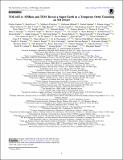| dc.description.abstract | <jats:title>Abstract</jats:title>
<jats:p>Exploring the properties of exoplanets near or inside the radius valley provides insight on the transition from the rocky super-Earths to the larger, hydrogen-rich atmosphere mini-Neptunes. Here, we report the discovery of TOI-1452b, a transiting super-Earth (<jats:italic>R</jats:italic>
<jats:sub>p</jats:sub> = 1.67 ± 0.07 <jats:italic>R</jats:italic>
<jats:sub>⊕</jats:sub>) in an 11.1 day temperate orbit (<jats:italic>T</jats:italic>
<jats:sub>eq</jats:sub> = 326 ± 7 K) around the primary member (<jats:italic>H</jats:italic> = 10.0, <jats:italic>T</jats:italic>
<jats:sub>eff</jats:sub> = 3185 ± 50 K) of a nearby visual-binary M dwarf. The transits were first detected by the Transiting Exoplanet Survey Satellite, then successfully isolated between the two 3.″2 companions with ground-based photometry from the Observatoire du Mont-Mégantic and MuSCAT3. The planetary nature of TOI-1452b was established through high-precision velocimetry with the near-infrared SPIRou spectropolarimeter as part of the ongoing SPIRou Legacy Survey. The measured planetary mass (4.8 ± 1.3 <jats:italic>M</jats:italic>
<jats:sub>⊕</jats:sub>) and inferred bulk density (<jats:inline-formula>
<jats:tex-math>
<?CDATA ${5.6}_{-1.6}^{+1.8}$?>
</jats:tex-math>
<mml:math xmlns:mml="http://www.w3.org/1998/Math/MathML" overflow="scroll">
<mml:msubsup>
<mml:mrow>
<mml:mn>5.6</mml:mn>
</mml:mrow>
<mml:mrow>
<mml:mo>−</mml:mo>
<mml:mn>1.6</mml:mn>
</mml:mrow>
<mml:mrow>
<mml:mo>+</mml:mo>
<mml:mn>1.8</mml:mn>
</mml:mrow>
</mml:msubsup>
</mml:math>
<jats:inline-graphic xmlns:xlink="http://www.w3.org/1999/xlink" xlink:href="ajac7ceaieqn1.gif" xlink:type="simple" />
</jats:inline-formula> g cm<jats:sup>−3</jats:sup>) is suggestive of a rocky core surrounded by a volatile-rich envelope. More quantitatively, the mass and radius of TOI-1452b, combined with the stellar abundance of refractory elements (Fe, Mg, and Si) measured by SPIRou, is consistent with a core-mass fraction of 18% ± 6% and a water-mass fraction of <jats:inline-formula>
<jats:tex-math>
<?CDATA ${22}_{-13}^{+21}$?>
</jats:tex-math>
<mml:math xmlns:mml="http://www.w3.org/1998/Math/MathML" overflow="scroll">
<mml:msubsup>
<mml:mrow>
<mml:mn>22</mml:mn>
</mml:mrow>
<mml:mrow>
<mml:mo>−</mml:mo>
<mml:mn>13</mml:mn>
</mml:mrow>
<mml:mrow>
<mml:mo>+</mml:mo>
<mml:mn>21</mml:mn>
</mml:mrow>
</mml:msubsup>
</mml:math>
<jats:inline-graphic xmlns:xlink="http://www.w3.org/1999/xlink" xlink:href="ajac7ceaieqn2.gif" xlink:type="simple" />
</jats:inline-formula>%. The water world candidate TOI-1452b is a prime target for future atmospheric characterization with JWST, featuring a transmission spectroscopy metric similar to other well-known temperate small planets such as LHS 1140b and K2-18 b. The system is located near Webb’s northern continuous viewing zone, implying that is can be followed at almost any moment of the year.</jats:p> | en_US |
| dspace.orderedauthors | Cadieux, C; Doyon, R; Plotnykov, M; Hébrard, G; Jahandar, F; Artigau, É; Valencia, D; Cook, NJ; Martioli, E; Vandal, T; Donati, J-F; Cloutier, R; Narita, N; Fukui, A; Hirano, T; Bouchy, F; Cowan, NB; Gonzales, EJ; Ciardi, DR; Stassun, KG; Arnold, L; Benneke, B; Boisse, I; Bonfils, X; Carmona, A; Cortés-Zuleta, P; Delfosse, X; Forveille, T; Fouqué, P; da Silva, JG; Jenkins, JM; Kiefer, F; Kóspál, Á; Lafrenière, D; Martins, JHC; Moutou, C; do Nascimento, J-D; Ould-Elhkim, M; Pelletier, S; Twicken, JD; Bouma, LG; Cartwright, S; Darveau-Bernier, A; Grankin, K; Ikoma, M; Kagetani, T; Kawauchi, K; Kodama, T; Kotani, T; Latham, DW; Menou, K; Ricker, G; Seager, S; Tamura, M; Vanderspek, R; Watanabe, N | en_US |
